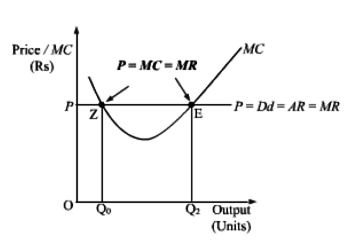Sponsor Area
Market Equilibrium
Why is the equality between marginal cost and marginal revenue necessary for a firm to be in equilibrium? Is it sufficient to ensure equilibrium? Explain.
Equilibrium refers to a state of rest when no change is required. A firm (producer) is said to be in equilibrium when it has no inclination to expand or to contract its output. This state either reflects maximum profits or minimum losses.
According to MC=MR approach, As long as MC is less than MR, it is profitable for the producer to go on producing more because it adds to its profits. He stops producing more only when MC becomes equal to MR.
When MC is greater than MR after equilibrium, it means producing more will lead to decline
in profits.
Both the conditions are needed for Firm’s Equilibrium:
1. MC = MR:
MR is the addition to TR from sale of one more unit of output and MC is addition to TC for
increasing production by one unit. Every producer aims to maximize the total profits. For
this, a firm compares it’s MR with its MC. Profits will increase as long as MR exceeds MC
and profits will fall if MR is less than MC. So, equilibrium is not achieved when MC < MR
as it is possible to add to profits by producing more. Producer is also not in equilibrium
when MC > MR because benefit is less than the cost. It means, the firm will be at
equilibrium when MC = MR.
2. MC is greater than MR after MC = MR output level:
MC = MR is a necessary condition, but not sufficient enough to ensure equilibrium. Only
that output level is the equilibrium output when MC becomes greater than MR after the
equilibrium.
It is because if MC is greater than MR, then producing beyond MC = MR output will reduce
profits. On the other hand, if MC is less than MR beyond MC = MR output, it is possible to
add to profits by producing more. So, first condition must be supplemented with the
second condition to attain the producer’s equilibrium.
Some More Questions From Market Equilibrium Chapter
Market for a good is in equilibrium. There is simultaneous decrease both in demand and supply of the good. Explain its effect on market price.
Market for a good is in equilibrium. There is an 'increase' in demand for this good. Explain the chain of effects of this change. Use diagram.
What is minimum price ceiling? Explain its implications.
If the prevailing market price is above the equilibrium price, explain its chain of effects.
The demand of a commodity when measured through the expenditure approach is inelastic. A fall in its price will result in :
(choose the correct alternative)
(a) no change in expenditure on it.
(b) increase in expenditure on it.
(c) decrease in expenditure on it.
(d) any one of the above
(choose the correct alternative)
(a) no change in expenditure on it.
(b) increase in expenditure on it.
(c) decrease in expenditure on it.
(d) any one of the above
As we move along a downward sloping straight line demand curve from left to right, price elasticity of demand : (choose the correct alternative)
(a) remains unchanged
(b) goes on falling
(c) goes on rising
(d) falls initially then rises
(a) remains unchanged
(b) goes on falling
(c) goes on rising
(d) falls initially then rises
Define market demand.
Show that demand of a commodity is inversely related to its price.
Explain with the help of utility analysis.
Or
Why is an indifference curve negatively sloped? Explain.
Explain with the help of utility analysis.
Or
Why is an indifference curve negatively sloped? Explain.
When price of a commodity X falls by 10 per cent, its demand rises from 150 units to 180 units. Calculate its price elasticity of demand. How much should be the percentage fall in its price so that its demand rises from 150 to 210 units ?
Complete the following table :
output units
total cost
average variable cost
marginal cost
average fixed cost
0
30
1
20
2
68
3
84
18
4
18
5
125
19
6
Sponsor Area
Mock Test Series
Mock Test Series





